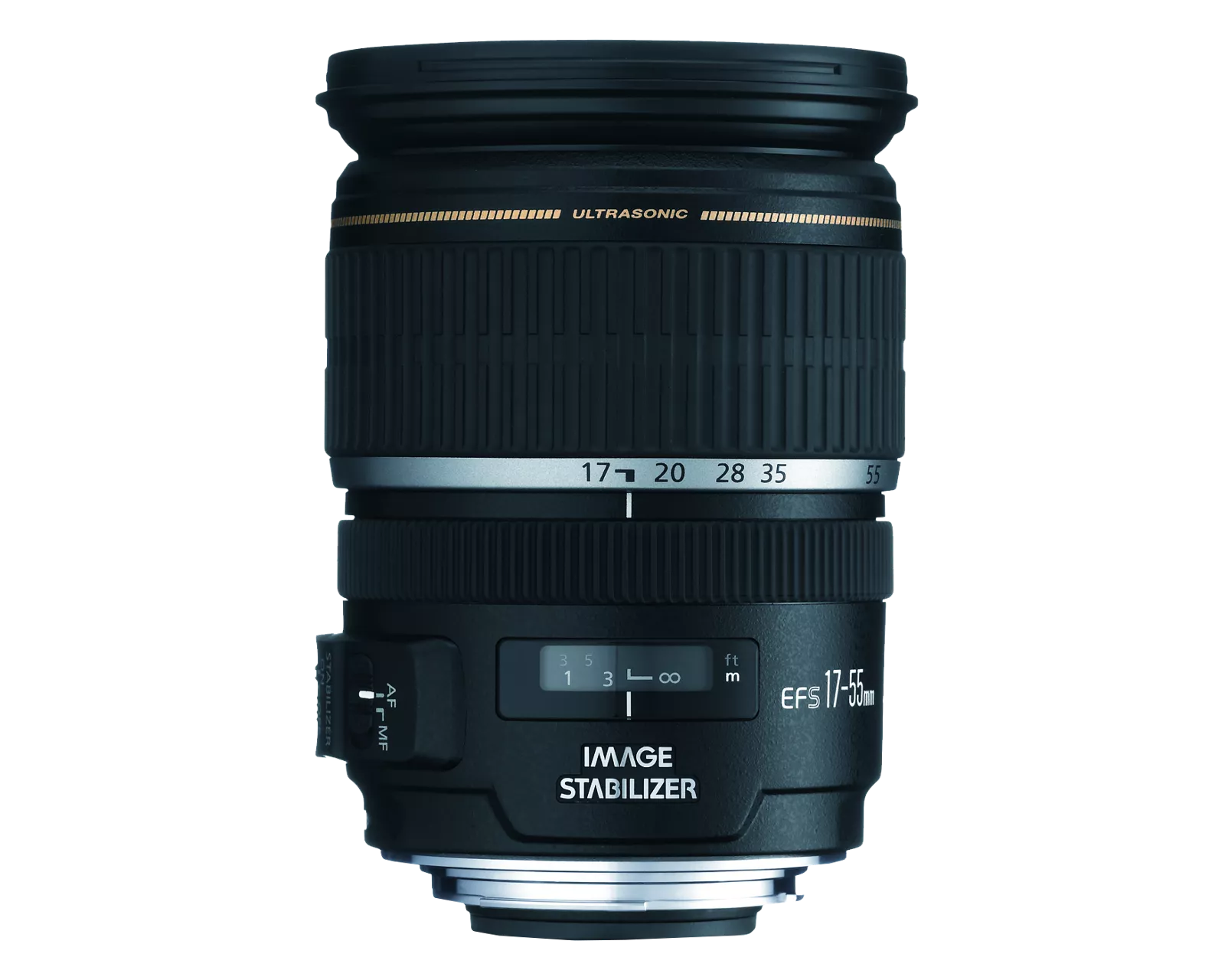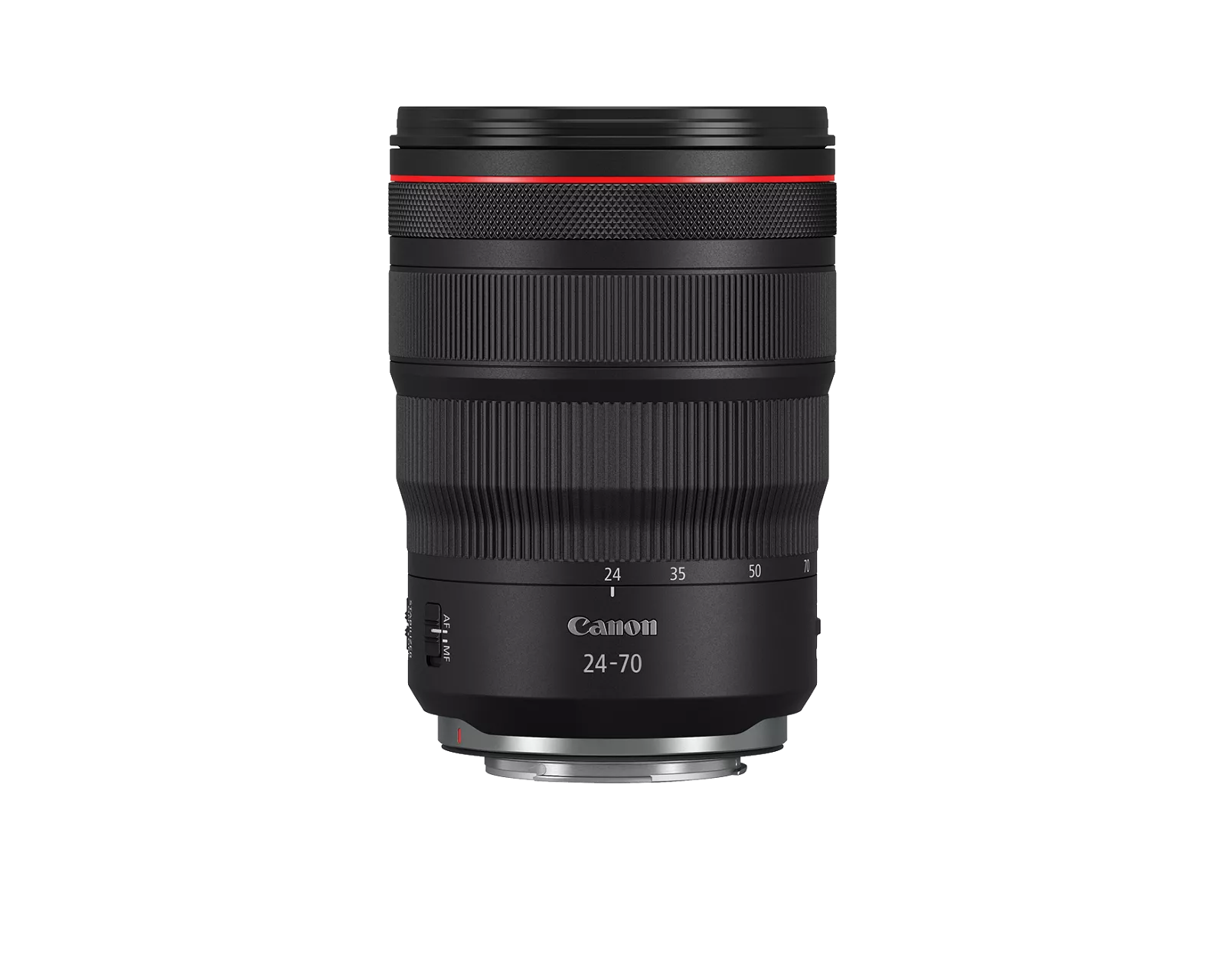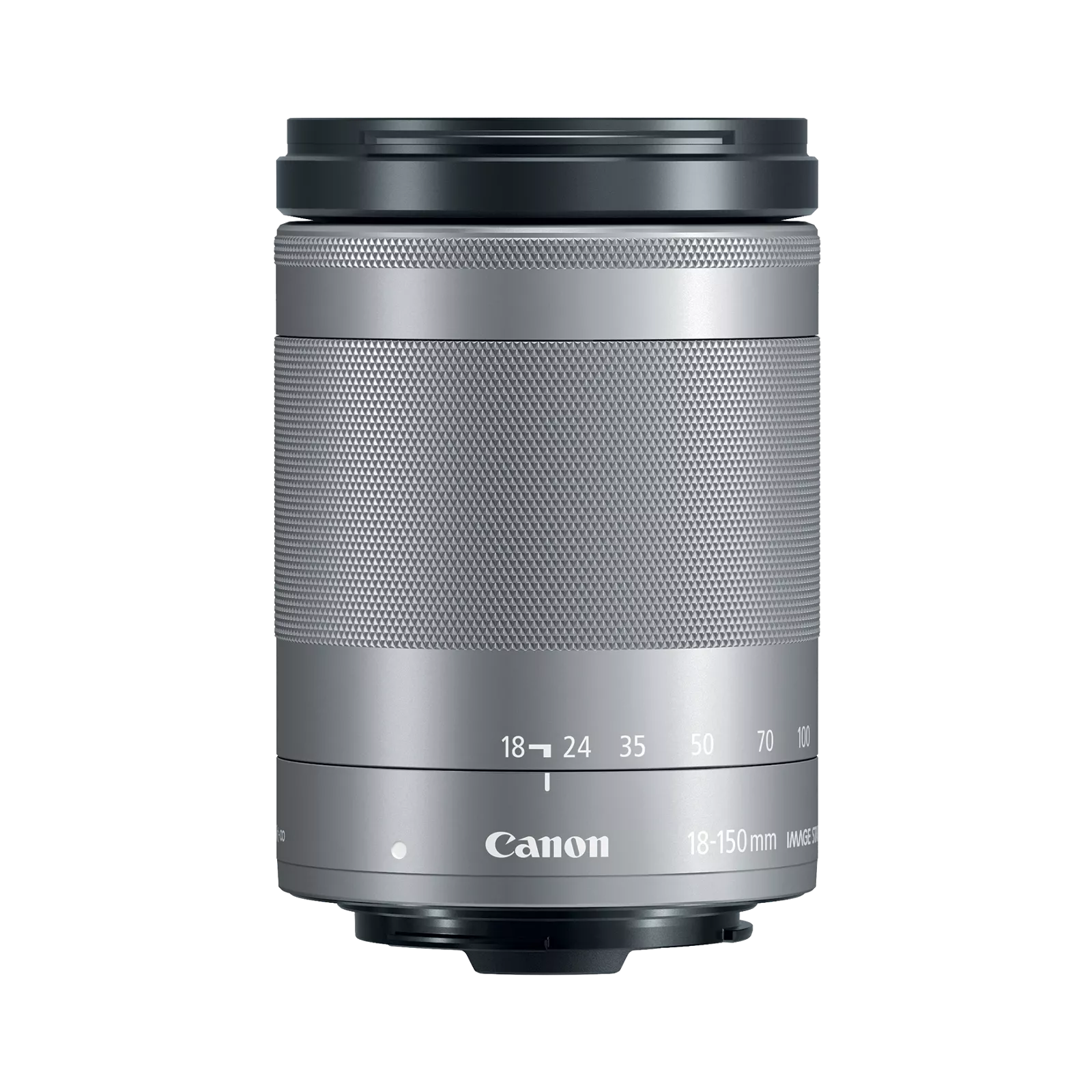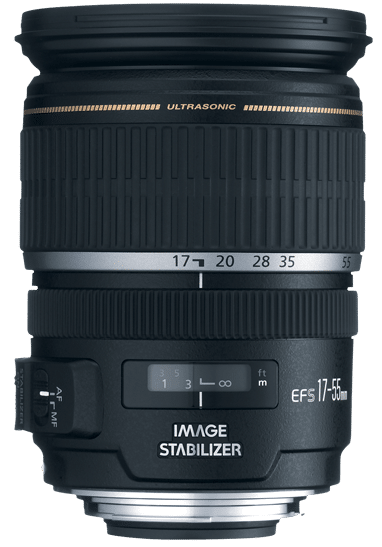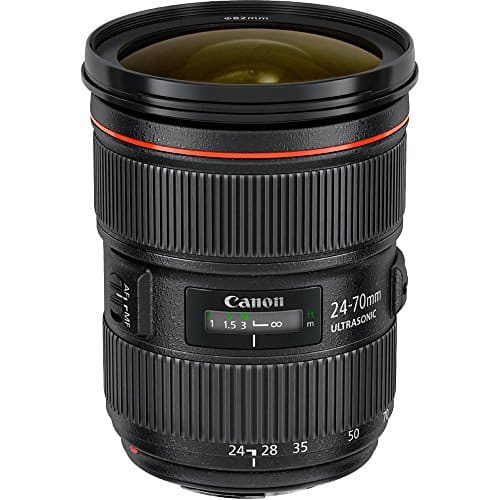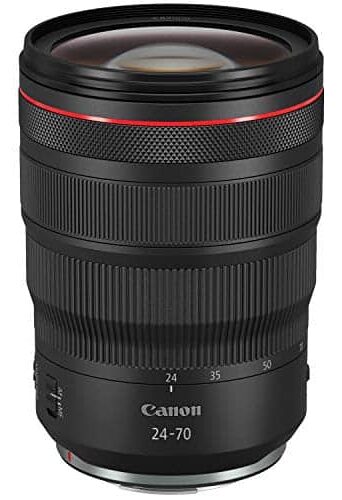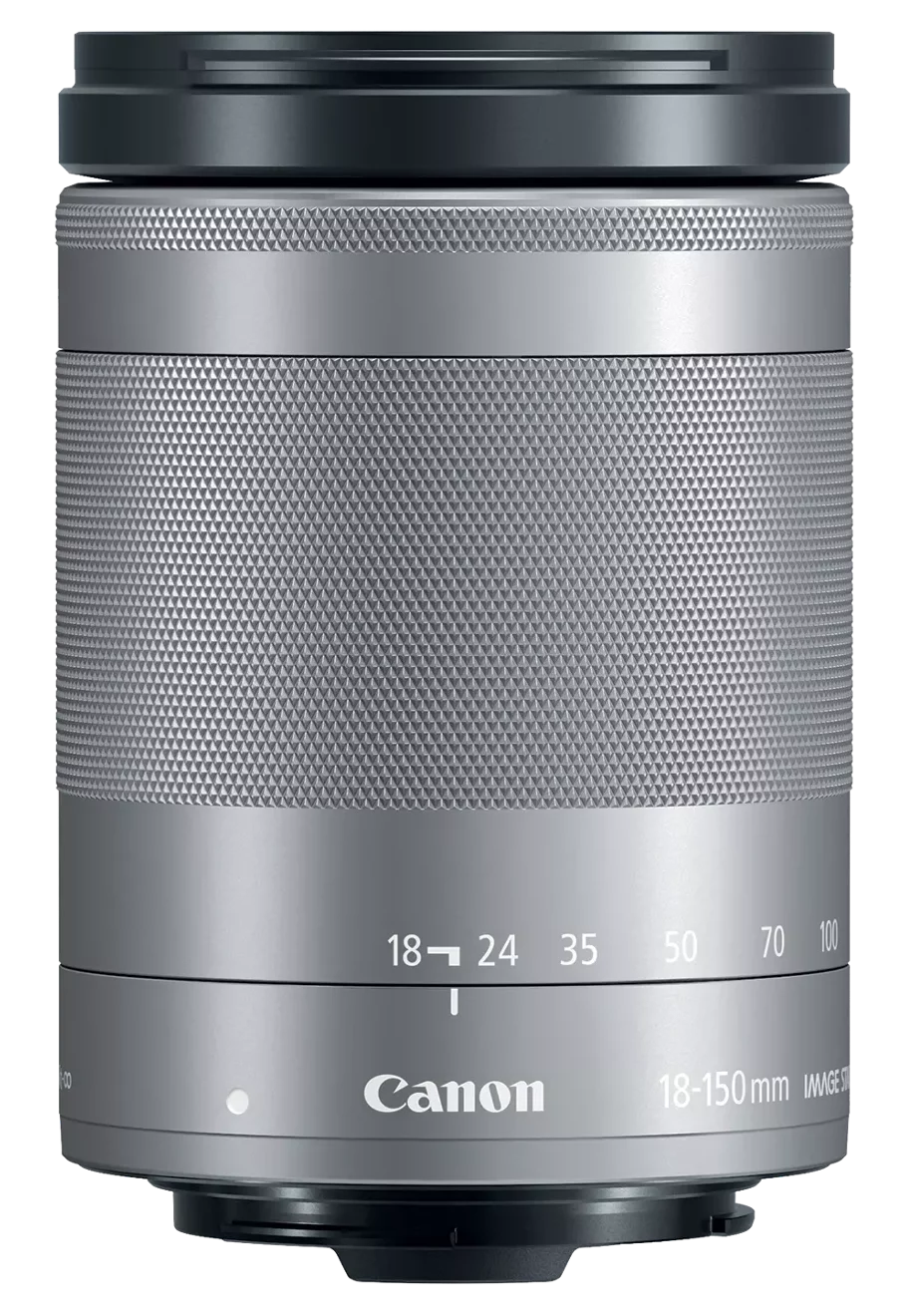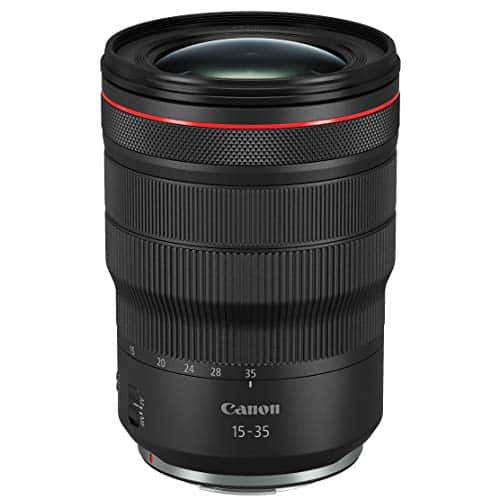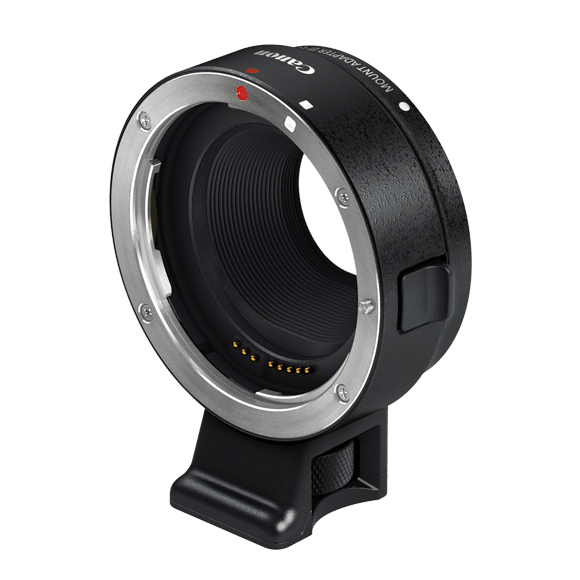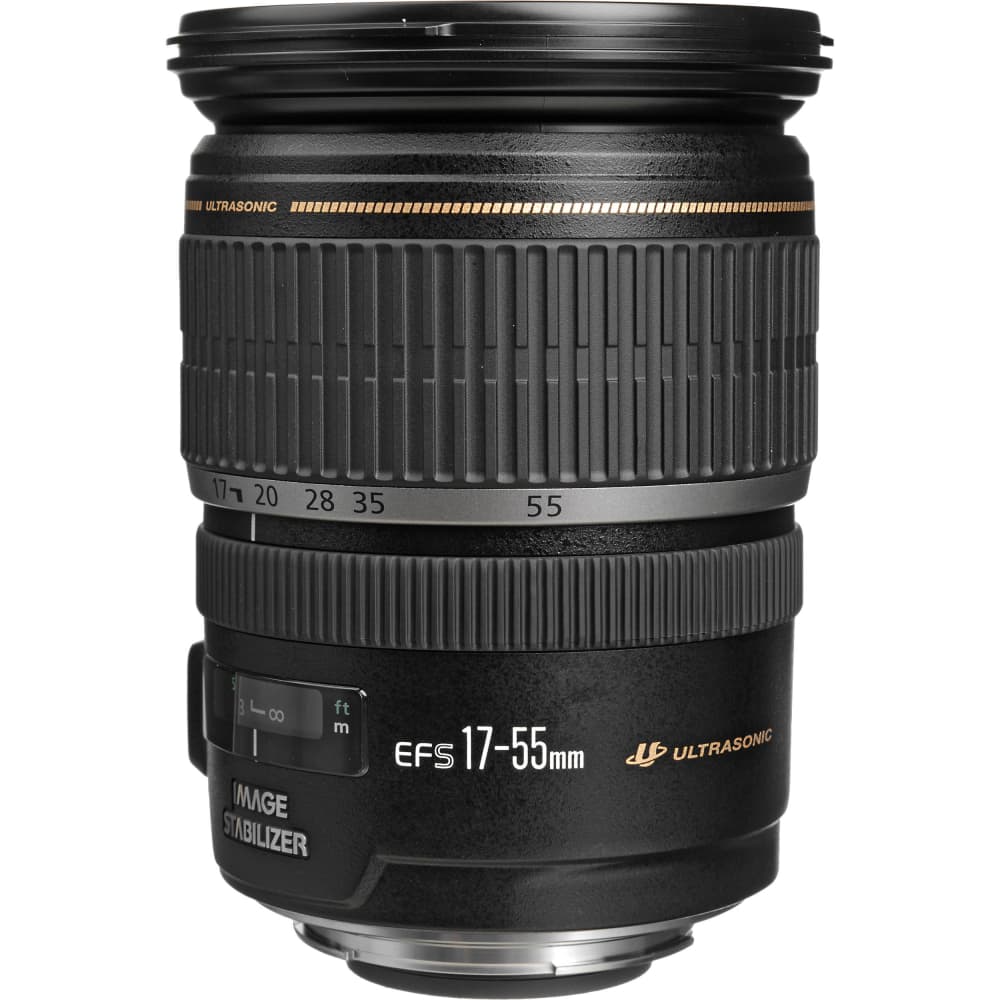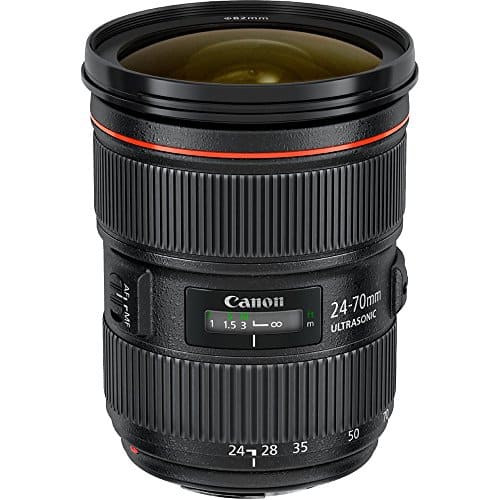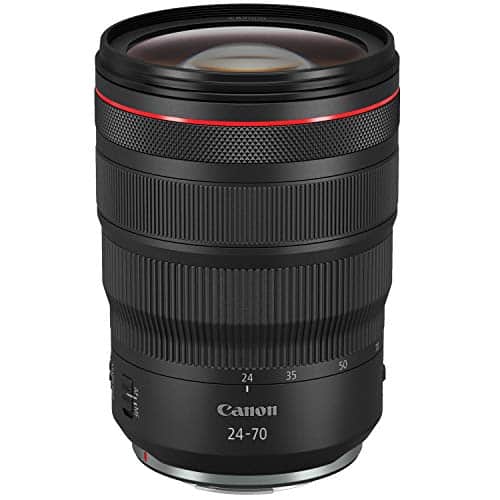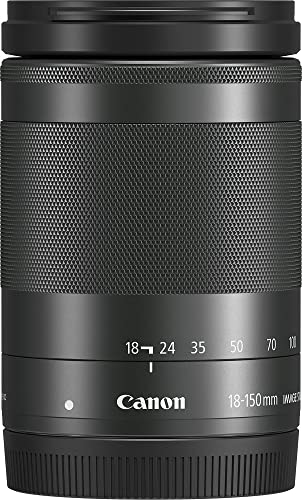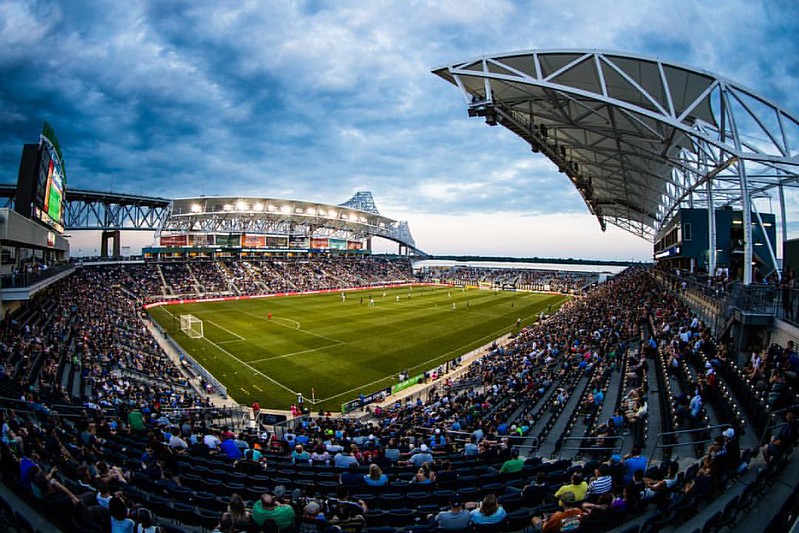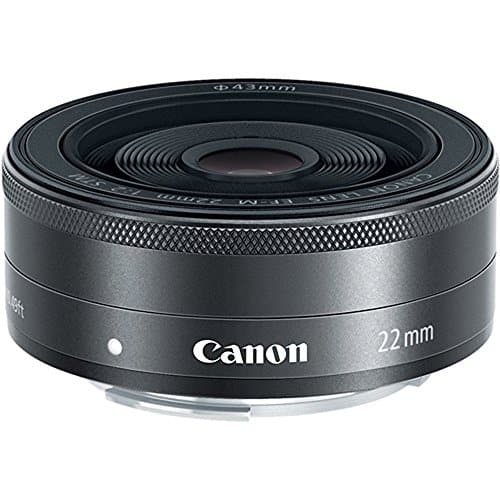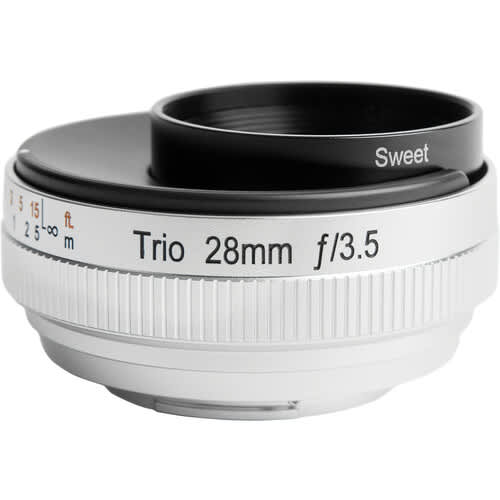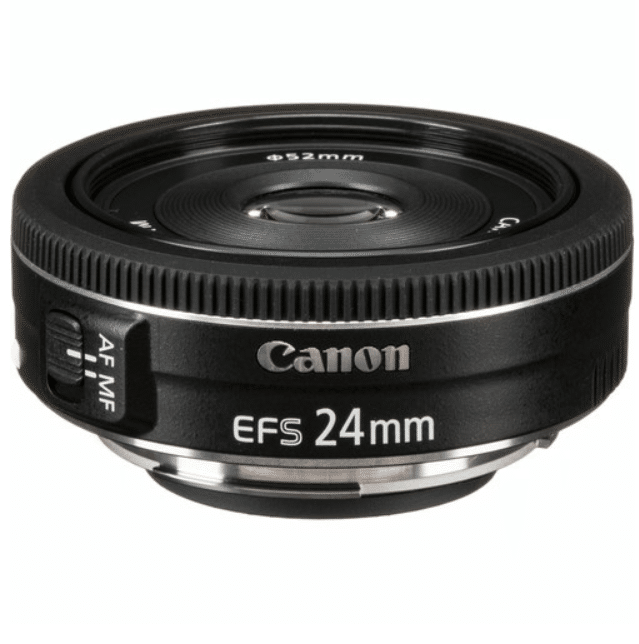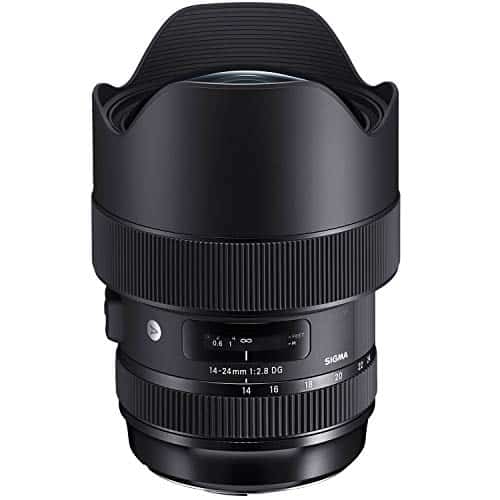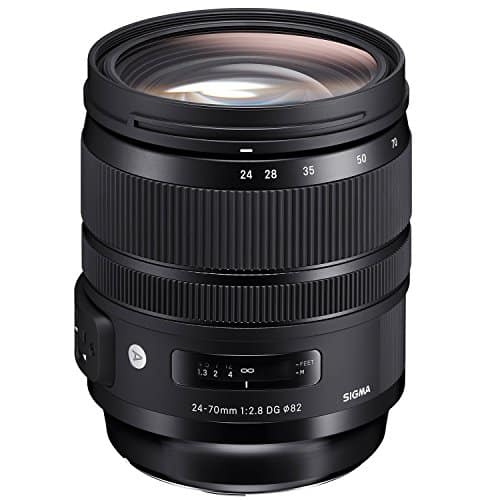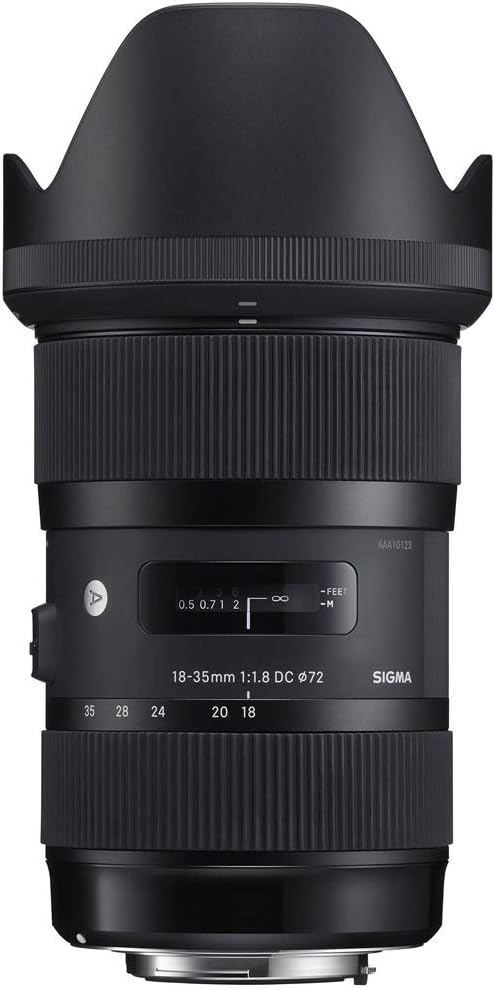[ If you buy gear from one of our links, we may make a commission at no cost to you. Thanks for supporting the blog—we appreciate you! Learn more. ]
Deep Dive into the Best Canon Lens for Video
Article by Colette Nichol, Solo Filmmaker and Story Strategist
“What is the BEST Canon lens for video!?!”
There are four top Canon lenses that are best for video. Whether you’re shooting with a full-frame camera or a crop-sensor camera, you need a standard zoom lens with a fixed maximum aperture of f/2.8 or faster.
In my opinion, if you have a Canon crop-sensor DSLR, the best lens for video is the 17-55mm f/2.8 IS USM lens. While if you have a full-frame DSLR, the best lens for video is the 24-70mm f/2.8L II USM lens.
If you have one of Canon’s newer professional mirrorless cameras like the R6 or R5, the best lens for video is the Canon RF 24-70mm f/2.8 L IS USM Lens. While if you have one of Canon’s consumer mirrorless cameras like the Canon EOS M50, the best lens for video is the EF-M 18-150mm which has a variable aperture of f/3.5-6.3.
If you have the budget for it, you can also use the RF 24-70mm f/2.8 L on a Canon M-mount cameras as long as you buy a good adaptor.
These zoom lenses are considered standard zooms, and any one of them would be a good addition to a videographer’s kit.
But before you buy a lens, make sure you know your lens mount.
Also, make sure you figure out what f-stop and focal lengths you need. Read more to get the details! This post will cover everything you need to know if you’re looking to buy a great Canon lens for video.
Best for Crop-Sensor DSLRs | Best for Full-Frame DSLRs | Best for RF Mirrorless | Best for M Series |
Fast lens is good in low light. Sharp with good colour rendition. Built to last. Image stabilization. Zoom range covers all major shot sizes. | Fixed max aperture of f/2.8 is good in low light. While the premium quality glass is built to last and help you create gorgeous imagery. | This fast and sharp lens is made with premium quality glass. Built to last a long-ass time. Image stabilized. Killer autofocus. Perfect for video. | Made to go with the lightweight M-mount mirrorless cameras and provide you with a mega zoom so you can start experimenting. |
Image Source: Canon | |||
But How Do We Know What the Best Lenses Are?
How we choose the best lenses is pretty simple. Canon, and other lens brands, don’t make redundant lenses.
They make one lens for each specific use case and ideal user. So when it comes to choosing a lens, it’s simple: you just need to know the lens specs, what they mean, and how you’re planning on using your lens.
The reason so many people buy the wrong lens when they’re starting out is because as early-stage video creators, they don’t know what ALL the specs mean.
That’s normal.
Also most blogs about lenses are made for photographers not video creators and filmmakers, making it really easy to get confused when buying.
Our gear posts are focused on providing the right info for video creators, solo filmmakers, and indie filmmakers who are ready to upgrade their gear.

Table of Contents
- My Lens Evolution
- Basic details about the best Canon lenses for videography
- How to Choose the Best Video Lens for Your Canon Camera
- The Absolute Best Lens for Canon
- Top 6 Best Canon Lenses for Video
- Beginner Canon Prime Lenses
- Navigating the World of Canon EOS Lenses
- Top Canon Video Lenses for Aspiring Filmmakers
- Canon’s Best Zoom Lenses for Videographers
- A Deeper Look at Canon Zoom Lenses
- Unleash Your Creativity with Unusual Canon Video Lenses
- Canon Low Aperture Lenses i.e Fast Lenses
- Choose the Right Wide Angle Lens for Your Canon Camera
- Canon EF Lenses vs EF-S Lenses
- Canon AF System
- Sigma and Canon: Best Sigma Lenses for Canon Cameras
- So What’s the Best Lens for You?
My Lens Evolution
I started out shooting on a point-and-shoot with a built in lens, but I FELT like something was missing.
But when I finally got my first DSLR, I became obsessed with filmmaking. My Canon Rebel T3i came with the standard plastic kit lens. And while that was OK to start, the time quickly came to buy some legit glass. It took me so long to finally go for it.
At the time, I wasn’t earning a lot. And the thought of buying something for myself that cost over $1000 seemed like pure madness.
When my husband came home the afternoon that my first fancy lens was delivered, he found me crying on the living room floor.
I was clutching onto the lens like it was some precious relic.
“Mi amor, is it weird that I’m so emotional about this!?!?” I hiccup out while still clutching the lens.
Probably I was hormonal. But still, that lens was a BIG DEAL!
The price had freaked me out because I’d never spent that much on gear before. But it turned out to be worth it.
Since then, I’ve gotten a few more fancy lenses and no longer find myself crying every time I spend large sums of money on gear. I now know first hand, that it’s worth it.
As long as I buy the RIGHT thing, I get my money’s worth.
If this is your first time spending substantial money on a lens, welcome! Buying a lens can feel overwhelming. But at the end of the day, it’s just a matter of getting the right specs to suit your needs and camera, and then going out and having fun with it!
Canon EF-S 17-55mm f/2.8 IS USM | |
Best for Crop-Sensor DSLRs like the Canon 90D and Rebel Series | |
Filter Size: 77mm | Weight: 1.42 lbs | Image Stabilized | |
What We Love: ✓ Perfect focal length range for video creators allowing you to get all the shot sizes you need. ✓ Fixed aperture of f/2.8 is important when filming in low light.
| Downsides: ✘ It will only work on a crop-sensor camera due to how it’s designed. ✘ It provides sharp images but isn’t as sharp as Canon L glass. |
Canon EF 24-70mm f/2.8L II USM Lens | |
Best for Full-Frame DSLRs or Crop-Sensor DSLRs | |
Filter Size: 82mm | Weight: 1.77 lbs | |
What We Love: ✓ Sharp w/ beautiful image quality ✓ Solid build - made to last a lifetime ✓ Fixed aperture of f/2.8 is great in low light. ✓ Perfect focal lengths for video. | Downsides: ✘ Not image stabilized. ✘ If you use this on a crop-sensor camera you’ll also need a wide-angle zoom to capture wide shots indoors. Canon EF 11-24mm f/4L is a good. |
Canon RF 24-70mm f/2.8 L IS USM | |
Best for R-Series Canon Mirrorless cameras like the R6 and R5 | |
Filter Size: 82mm | Weight: 1.98 lbs | |
What We Love: ✓ Beautiful image quality ✓ Built to last a lifetime ✓ Fixed aperture of f/2.8 ✓ Perfect focal length range for your full-frame Canon mirrorless ✓ Great auto focus | Downsides: ✘ You can’t use this lens on a Canon DSLR or the BMPCC 6k — it’s strictly for use on the R-series cameras. ✘ This lens is pricey due to the fact that it’s high-end glass with a fast aperture and image stabilized. |
Canon EF-M 18-150mm f/3.5-6.3 IS STM | |
Best for M-mount consumer mirrorless cameras like the M50. | |
Filter Size: 55mm | Weight: 0.66 lbs | |
What We Love: ✓ Typically costs under $600 US ✓ Much better quality than the kit lens that comes with your M-mount. ✓ Zoom covers wide angle through telephoto - versatile ✓ Light weight. | Downsides: ✘ You can’t use this lens on any other camera outside the Canon M-mounts. ✘ I’m not a fan of variable aperture (f/2.5-6.3) on lenses especially for video creators. Don’t expect outstanding results indoors in low light. |
*For most video creators who use tripods, monopods, shoulder rigs, or gimbals, you don’t need a lens with IS (Image Stabilization). It’s nice to have but not a must. If you’re going to do a ton of handheld, the you should probably have mirrorless camera with 5-axis stabilization. Otherwise no matter what you do, the footage will probably be wobbly.
But wait, there’s more!
If you really want to UNDERSTAND lenses before buying one, read through the rest of this post.
If you just want to buy something asap, go with one of the four lenses I just suggested and as long as you get the right lens for your camera mount, you’ll be OK.
But for those of you who like to get into the details, keep reading this post to make sure you don’t buy the wrong lens for your camera or don’t end up with something less than perfect. Because there are plenty of choices, and it’s easy to get confused and buy something that isn’t right for you.
Before giving you more details about the best Canon lenses for videography let’s cover the basics:
First you need to know what your Canon camera’s lens mount is, the focal length you need, how often you’ll be shooting in low light, and what you’re willing to spend.
WHAT YOU NEED TO KNOW TO BUY THE RIGHT CANON LENS:
- Your camera’s lens mount.
- Whether low-light is an issue for you.
- The focal length you need.
- Your budget.
As a video shooter, getting a zoom is absolutely key.
You need to be able to switch up your focal length on the fly when shooting video. But having a wide enough aperture to allow you to handle low light and throw the background out of focus is also important.
Also, please don’t get fooled by photography blogs telling you that you need a 50mm prime lens because you really, really, don’t.
And if you’re not sure what a focal length is, I’ll go over that too!
Fear not.
STORY ENVELOPE FILMMAKING LETTER
Get filmmaking tips to your inbox once per week, plus the free Mini Filmmaking Course.
Join 2000+ filmmakers, and get filmmaking tips, lessons, gear tips, stories, and motivation! Also, whenever I write an epic (ultra long and useful) blog post about filmmaking, I’ll send it to you.
How to Choose the Best Video Lens for Your Canon Camera
To choose the best video lens for your camera, you need to know which of the main Canon lens mounts your camera has.
If you have a Canon camera or a Blackmagic camera with a Canon lens mount then you have one of four possible mounts: EF, EF-S, EF-M, or RF.
Know Your Canon Lens Mount
- Crop-sensor DSLRs have the EF-S mount but can also take EF lenses.
- Full-frame DSLRs have an EF mount.
- Budget mirrorless cameras have the EF-M mount.
- Crop-sensor high-end mirrorless cameras have the RF mount.
- Full-frame mirrorless cameras have the RF mount.
How to Figure Out Your Lens Mount
- Refer to the list below to see if your camera is there.
- Open up the B&H website.
- Type in your camera name.
- Go to the specs.
- Find the lens mount.
Top Canon Camera Lens Mounts | |
Camera Body | Lens Mount |
Canon 90D | EF-S |
Canon EOS Rebel T7 | EF-S |
Canon EOS Rebel T8i | EF-S |
Canon EOS Rebel SL3
| EF-S |
Canon EOS Rebel T100 | EF-S |
Canon EOS 90D | EF-S |
Canon EOS 5D Mark IV | EF |
Canon EOS 6D Mark II | EF |
Canon EOS 5D Mark IV DSLR | EF |
Canon EOS-1D X Mark II | EF |
Canon EOS M50 Mark II | EF-M |
Canon EOS M200 | EF-M |
Canon EOS R5 | RF |
Canon EOS R6 | RF |
Canon EOS R6 Mark II | RF |
Canon EOS R7 | RF |
Canon EOS R8 | RF |
Canon EOS R5 C | RF |
Canon EOS R3 | RF |
Canon EOS RP | RF |
Canon EOS R50 | RF |
Canon EOS R10 | RF |
Know Your Aperture Requirements
Next, decide if you’re going to be shooting a lot of footage indoors.
If that’s the case, you need a lens with a fixed aperture of f/2.8.
The aperture is the opening in the lens that lets light into the camera. If you are shooting indoors a lot, you need more light. The opening size of the aperture is indicated in f numbers which we call f-stops.
A lens with a fixed aperture of f/2.8 or lower is considered “fast.”

A lens with a fixed aperture of f/2.8 can let in lots of light and will be a great investment.
For anyone working in low-light situations frequently a fast lens is a must. Shooting indoors and at night are both situations where having a fast lens is essential.
For each full stop you’re able to let in twice the amount of light. So a lens with a max aperture of f/2.8 will let in twice the amount of light as a lens with a max aperture of f/4.0.
I’ve found that if you’re shooting with a DSLR or mirrorless camera indoors without studio lights, you want all the light you can get coming in that lens!
So if your budget allows it, I recommend getting a lens with a fixed aperture of f/2.8 or lower.

Variable Aperture Lenses
A variable aperture lens can be a pain. When you’re using a variable aperture lens, you won’t be able to access the full width of the aperture on all focal lengths. In practice, this is a real pain in the butt. You’re indoors, and you go to shoot a close up and suddenly you can’t stop up to f/2.8!
Not good. Very annoying.
Know Your Focal Length Requirements
Getting a zoom lens is key if you’re a video shooter.
But how much zoom do you need? Just start out with a standard zoom that covers a medium wide angle and also allows for decent close up shots.
A standard medium shot can be easily captured with a 35mm or 50mm lens on a full frame camera. But most Canon crop-sensor cameras have a crop factor of 1.6x, which means that your frame is 1.6x tighter on your crop-sensor camera than it is on a full-frame camera.
In practice, this means you need wider angle lenses for your crop-sensor camera than for a full-frame camera.
Best Focal Length Range for Normal Shooters with a Full-Frame Camera
24-70mm
Best Focal Length Range for a Crop-Sensor Camera with 1.6x Crop Factor
17-55mm
If you need a telephoto lens because you’re going to be shooting sports or doing nature videography, that’s going to go in a separate post. But suffice it to say that you’ll need a focal length that’s 200mm or more to do that.

The Absolute Best Lens for Canon
The absolute “best” lenses for Canon cameras are L glass.
These lenses have a red stripe around the rim and are made with premium optical glass which provides crisp saturated images. They have outstanding auto focus and are basically “forever” lenses. Both the RF series and the EF series of lenses have L-glass options. Just look for the letter L and the red circle around the rim of the lens.
So is L glass worth it?
Well, yes.
If you have the budget and are investing for the long-term then your L-glass lens will give you superior sharpness, colour, bokeh, auto focus, speed, and build quality. And they also hold value so you can re-sell them in a couple years if necessary without too much loss in value.
Best L Glass for Canon Full-frame and Crop Sensor DSLRs
Canon EF 24-70mm f/2.8L II USM Lens
Why: Premium glass built to last. This lens will not need to be replaced any time soon. Good in low-light conditions and provides all the standard focal lengths need for videography.
Best L Glass for R-Series Full Frame Mirrorless Cameras
Canon RF 24-70mm f/2.8 L IS USM Lens
Why: Ultra premium lens, watersealed and built to last a long-ass time. Insane auto focus perfect for video with a fast aperture allowing it to work well in low light situations.
▶️Check Best Deals
Best L Glass for R-Series Crop Sensor Cameras
Canon RF 15-35mm f/2.8 L IS USM Lens
Why: If you need wide angles for interiors or landscapes, this is your lens. With a fast aperture allowing you to get shallow depth of field, this lens will not need to be replaced any time soon.
Canon RF 28-70mm f/2 L USM Lens
Why: If you just get the 15-35mm zoom, you’re not going to be able to capture close ups and medium close ups easily. This lens will allow you to more easily get in a close and capture intimate shots.
Canon RF 70-200mm f/4 L IS USM Lens
Why: If you’re shooting sports or do a lot of close ups, this is the lens for the job. You’ll still likely want to have the wider angle zoom for interiors and landscapes. Outstanding autofocus means you won’t miss the shot.
Best L Glass for Canon M-Series Camera
Canon EF-M Lens Adapter Kit for Canon EF / EF-S Lenses
Why: Canon doesn’t have L glass specifically for the M-series camera, but you can get a high-quality adaptor and then use premium glass on your budget mirrorless. This is smart if you plan on upgrading your camera in the future but want to start shooting with a great lens first.
Canon EF 24-70mm f/2.8L II USM Lens
Why: This lens will give you the equivalent of a 38 to 112mm. You won’t have a wide angle with this lens, but you’ll have what you need for medium shot, close ups and extreme close ups. To get the wide angle coverage, you’ll need to get the Canon 16-35mm f/4 or 16-35mm f/2.8.
Top 6 Best Canon Lenses for Video
So now that you’ve waded through all this information about lense and how to pick the right lens, here are the top 6 Canon lenses for video, in my humble opinion. As someone who has been shooting with Canon cameras and glass since 2013, I’ve got a pretty good sense of what works for video.
But here’s the truth: buying lenses is all about the specs.
As long as you’ve got the right lens mount and the specs line up with what you want to do, you’re safe to make the purchase.
Canon EF-S 17-55mm f/2.8 IS USM Lens | Best option for crop-sensor DSLRs | |
Canon EF 24-70mm f/2.8L II USM Lens | For full-frame DSLRs - good in low light | |
Canon EF 70-200mm f/4L IS II USM Lens | For full-frame DSLRs - lower cost option | |
Canon RF 24-70mm f/2.8 L IS USM Lens | Standard zoom for mirrorless R mount | |
Canon RF 14-35mm f/4 L IS USM Lens | Wide angle for mirrorless R mount | |
Canon RF 24-105mm f/4 L IS USM Lens | Budget-friendly for mirrorless R mount | |
Canon EF-M 18-150mm f/3.5-6.3 IS STM Lens | Budget-friendly lens for Canon M series |
Beginner Canon Prime Lenses
First, since you’re here, reading a post about best Canon lenses for videography, I know that you’re interested in making moving pictures.
Which means, getting a prime lens ie. a lens with a fixed focal length is probably not in your best interest.
Most gear sites online are for photographers, and they often give the advice to buy a prime lens. For photographers that makes sense. Prime lenses are sharper and typically offer great quality for a reasonable price. However, as a solo filmmaker or video creator, prime lenses are usually a nightmare.
To cut a video together, you need to get a lot of different angles and shot sizes. It’s way harder to pull this off when using fixed focal length lenses.
But, if you insist on buying a Canon prime lens for video, here’s my suggestion:
- If you have a full-frame camera, get a 35mm or 50 mm prime lens.
- If you have a crop-sensor camera with a crop factor 1.5x or 1.6x get a 25mm or 35mm prime lens.
These are your top options for Canon EF primes:
- Canon EF 35mm f/2 IS USM Lens – under $600
- Sigma 30mm f/1.4 DC HSM Art Lens for Canon EF – under $500
- Canon EF 50mm f/1.4 USM Lens – Under $500
- Sigma 50mm f/1.4 DG HSM Art Lens for Canon EF – Under $1200
These are your options for cinema primes with Canon EF mounts priced under $500:
- Rokinon 14mm T3.1 Cine DS Lens for Canon EF Mount
- Rokinon 24mm T1.5 Cine DS Lens for Canon EF Mount
- Rokinon 35mm T1.5 Cine DS Lens for Canon EF Mount
- Rokinon 50mm T1.5 AS UMC Cine DS Lens for Canon EF Mount
- Rokinon 85mm T1.5 Cine DS Lens for Canon EF Mount
Or if you want more than one cinema prime (which would be logical if you’re making narrative shorts) then you should probably. just get the Rokinon Cine Lens Bundle as will save you some money.
Rokinon 24, 35, 50, 85mm T1.5 Cine DS Lens Bundle for Canon EF Mount
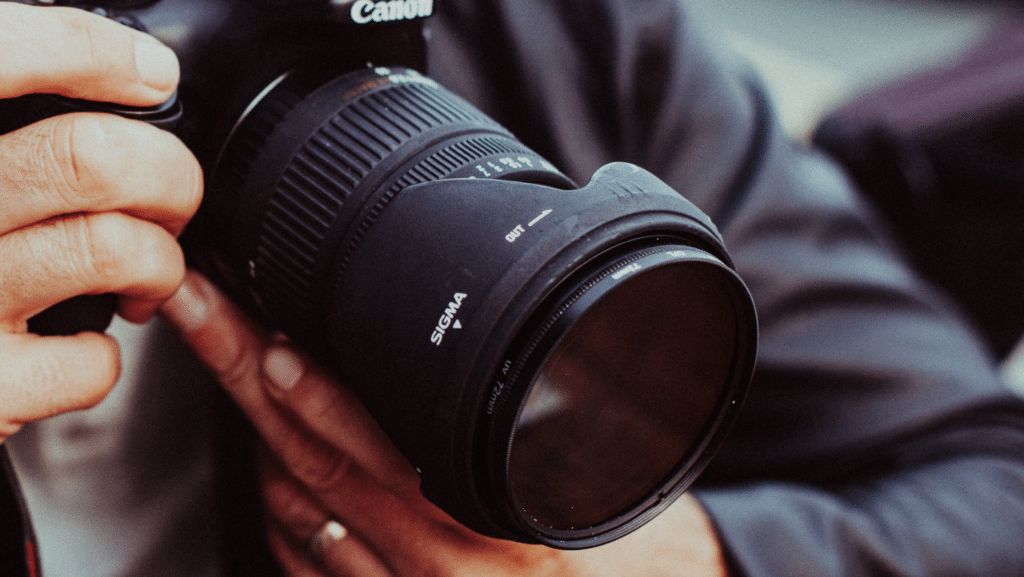
Navigating the World of Canon EOS Lenses
When navigation the world of Canon EOS Lenses, here are the main things you need to know:
- IS refers to image stabilization.
- USM refers to Ultra Sonic Motor i.e. how the lens manages to pull of fancy auto focus moves.
- L refers to L-glass which is high-end ultra-premium glass.
- The red ring around a lens means it’s L-glass.
- Any time you see f/ followed by a number, this refers to the aperture (opening) in the lens.
- f/2.8 or lower lets in lots of light and is good for low-light situations.
- Lenses that have a max aperture of f/4.0 are still good, but they’re not ideal for shooters who will be filming inside without studio lights.
Top Canon Video Lenses for Aspiring Filmmakers
The top Canon video lenses for aspiring filmmakers are the L-series and RF lenses. They aren’t necessarily going to be the perfect choice for you. But they are the best quality Canon lenses. You can put Canon L glass on any Canon DSLR, whether you have a crop-sensor camera with an EF-S mount or a full-frame camera with an EF mount.
And if you’re using a Canon R-series camera, you can put an RF lens on your camera. While if you’re using a Canon M-series camera, you’ll need to use an EF-M lens.
Best for Crop-Sensor DSLRs | Best for Full-Frame DSLRs | Best for RF Mirrorless | Best for M Series |
Fast lens is good in low light. Sharp with good colour rendition. Built to last. Image stabilization. Zoom range covers all major shot sizes. | Fixed max aperture of f/2.8 is good in low light. While the premium quality glass is built to last and help you create gorgeous imagery. | This fast and sharp lens is made with premium quality glass. Built to last a long-ass time. Image stabilized. Killer autofocus. Perfect for video. | Made to go with the lightweight M-mount mirrorless cameras and provide you with a mega zoom so you can start experimenting. |
Canon’s Best Zoom Lenses for Videographers
These are the top Canon Zoom lenses for videographers:
EF & EF-S
Canon EF 24-70mm f/2.8L II USM Lens (standard for full-frame)
Canon EF-S 17-55mm f/2.8 IS USM Lens (standard for crop-sensor)
Canon EF 70-200mm f/4L IS II USM Lens (telephoto)
RF
Canon RF 15-35mm f/2.8 L IS USM Lens (wide angle)
Canon RF 24-70mm f/2.8 L IS USM Lens (standard)
Canon RF 70-200mm f/4 L IS USM Lens (telephoto)
Canon RF 24-105mm f/4 L IS USM Lens (budget friendly)
EF-M
Canon EF-M 18-150mm f/3.5-6.3 IS USM Lens (budget friendly)
A Deeper Look at Canon Zoom Lenses
There are two main markings that you’ll notice on Canon zoom lenses: USM and IS.
USM
USM stands for “Ultrasonic Motor.”
It is a type of autofocus motor used in some Canon lenses. It uses ultrasonic vibrations to drive the focus group of elements within the lens. This technology often provides faster and quieter autofocus performance compared to other types of focus motors.
There are two types of USM that Canon uses:
Ring-type USM: This is the more advanced and better-performing of the two types. Lenses with a ring-type USM are generally faster, quieter, and more accurate. They also typically offer full-time manual focus, meaning you can manually adjust focus at any time, even without switching out of autofocus mode.
Micro USM: This is a smaller and less expensive version of the ring-type USM. Micro USM is not quite as fast or quiet as the ring-type, and not all micro USM lenses offer full-time manual focus.
USM technology is one of the main features that distinguish Canon’s higher-end lenses from their more budget-friendly options.
IS vs. not IS
IS on Canon lenses stands for “Image Stabilization.”
It is a technology used to reduce the blurring associated with the motion of a camera during exposure. Basically, it stabilizes the image that comes into the lens to allow for a clearer photo, especially in situations where the camera is handheld or in low light situations.
For video shooters, IS is useful when shooting at longer focal lengths, which can amplify visible camera shake or when shooting handheld.
However, if your handheld is super wobbly, IS won’t be able to compensate for that. In such cases you need stabilization in the camera body and the lens. In Body Image Stabilization, also called IBIS, is required if you’re shooting run-and-gun handheld and need your camera movement to appear smooth. A lens alone won’t be able to give you that.
Also, please note that using IS consumes more battery power from the camera than shooting without it. But, most Canon lenses with IS allow you to turn the function off when it’s not needed, such as when you’re using a tripod.
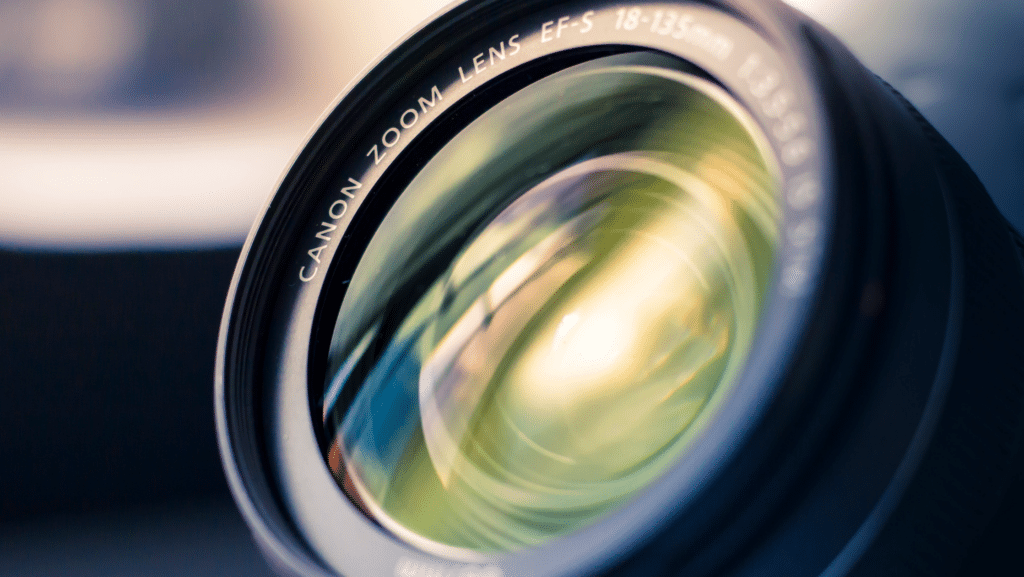
Unleash Your Creativity with Unusual Canon Video Lenses
Best Canon Macro Lens
A macro lens is optimized to allow you to get super close to the subject or object, and thus capture extreme close ups.
With a macro lens, you can focus extremely closely on a subject, allowing it to fill the frame with the maximum amount of detail.
This type of lens is commonly used for filming small slow moving or inanimate subjects like insects, flowers at very close distances. A macro lens can be useful for doing super extreme close ups.
The Canon EF 100mm f/2.8L Macro is the one that I use, and I absolutely love it. I’m only sad I can’t use it for every single shot.
Canon EF 100mm f/2.8L Macro IS USM Lens
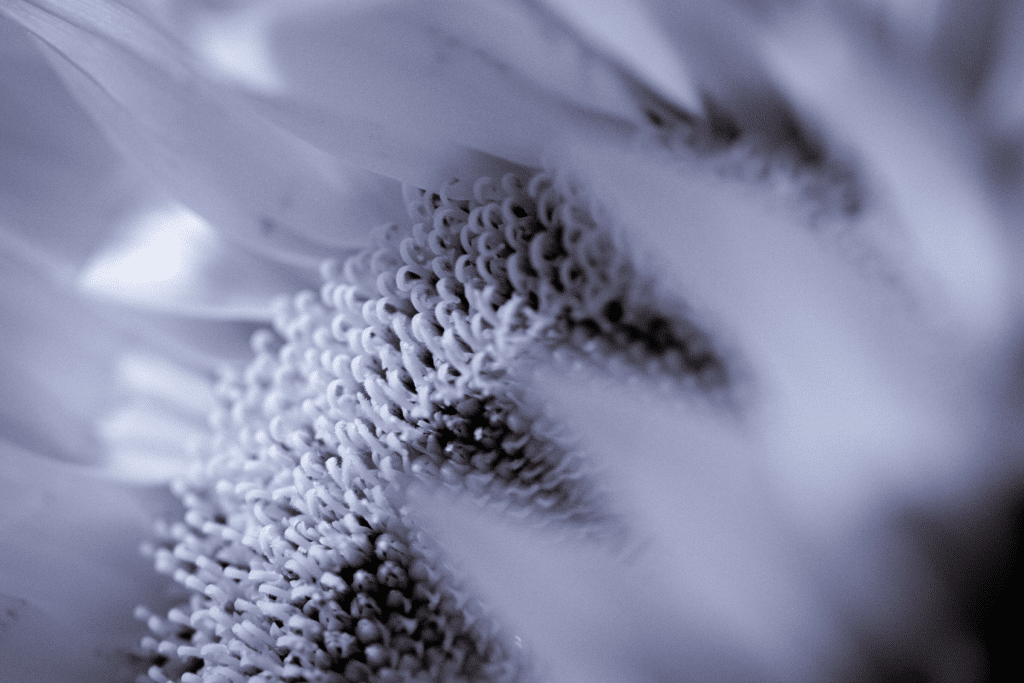
Best Canon Fisheye Lenses
A fisheye lens is a type of ultra wide-angle lens that creates a distinct visual distortion intended to create a wide panoramic or hemispherical image.
Named for the way a fish might see the world from under the water, these lenses achieve extremely wide angles of view by forgoing producing images with straight lines of perspective (rectilinear images), opting instead for a special mapping, which gives images a characteristic convex non-rectilinear appearance.
Canon EF 8-15mm f/4L Fisheye USM Len
Rokinon 8mm f/3.5 Fisheye Lens for Canon EF
Best Canon Pancake Lenses
A pancake lens is designed to be particularly thin and lightweight, hence the name “pancake”.
These lenses have a flat profile compared to other types of lenses and are popular for their compact and portable design.
Pancake lenses are prime lenses and often have a moderate wide-angle to standard focal length. Their optical design tends to be simpler, often leading to fewer elements, which can result in fewer chances for optical aberrations and sometimes sharper images.
Their slim design makes them ideal for travel and any other situations where you want a lightweight and unobtrusive setup.
They’re also popular for use with mirrorless cameras, which are often chosen for their smaller size compared to DSLRs.
M Series | R Series Cameras | Crop-Sensor DSLR |
Fast lens is good in low light. Very light weight. At this price point, you're not getting premium glass. But it's a good walking around lens. Under $250 | This is a good medium-quality lens for travel photography and street photography. If you want something cheap and cheerful, this is it! | If you have a Canon crop-sensor DSLR, you might want a super lightweight lens that also happens to be fast. This'll do the trick. |
Best Canon Pancake Lens for M-Series:
Best Canon Pancake Lens for R-Series:
Best Canon Pancake Lens for Canon APS-C (crop-sensor) Cameras:
Best Canon Pancake Lens for Full-Frame DSLRs:
- There currently is no lens that I can find for full-frame Canon DSLRs.

Canon Low Aperture Lenses i.e Fast Lenses
A fast lens is a lens with an f/stop of f.2.8 or lower.
This allows tons of light to enter the lens. Remember that for every full stop, you are able to double the light that enters the lens. This is very important when you’re shooting at night or indoors without studio lights.
In this post, I steer away from recommending lenses with an f-stop of 4.0 or higher because they aren’t ideal for video shooters.
It’s much harder for us to remove noise in post – compared to photographers. So we don’t want to be ramping up our ISO like crazy in order to get a properly exposed image.
Meanwhile, unless you’re shooting RAW video, you can’t do too much to fix underexposed video in post.
So, you really need to let enough light into your camera in the first place.
Low Aperture (Fast) EF and EF-S Lenses for Video
Canon EF-S 17-55mm f/2.8 IS USM Lens
Canon EF 24-70mm f/2.8L II USM Lens
Canon EF 16-35mm f/2.8L III USM Lens
Canon EF 70-200mm f/2.8L IS III USM Lens
Low Aperture (Fast) RF Lenses for Video
Canon RF 24-70mm f/2.8 L IS USM Lens
Canon RF 28-70mm f/2 L USM Lens
Canon RF 70-200mm f/2.8 L IS USM Lens
Choose the Right Wide Angle Lens for Your Canon Camera
Next, do you need a wide angle lens for your camera?
There are three main reasons you might need a wide angle lens:
- You want to shoot majestic landscapes
- You’ll be shooting interiors and need to get the entire width of a space whether it’s a large or small space.
- You’re shooting weddings or events, and you need to be able to get the entire space for a few shots.
So the next question is whether you need a regular wide angle or an ultra wide angle lens.
If you don’t have any premium lenses, yet, get started with a standard zoom lens which already has a wide angle on the lower end of the focal length. See if you really need anything wider than that, and go from there.
If you already know you’ll need an ultra wide angle lens, these are two main options:
1 – Rokinon 14mm T3.1 Cine DS Lens for Canon EF Mount – This won’t be ultra-wide on a crop sensor.
2 – Rokinon 8mm f/3.5 Fisheye Lens for Canon EF – As a fisheye lens the image will be distorted.
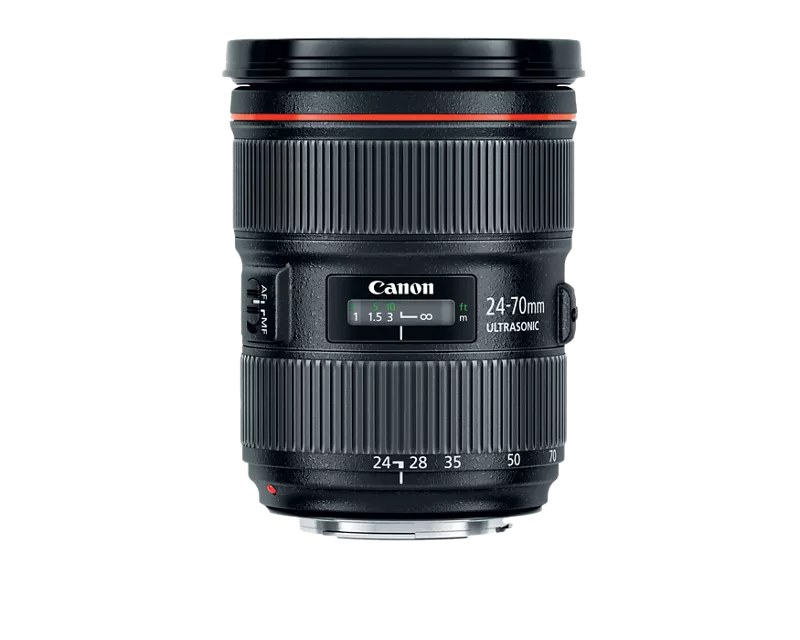
Canon EF Lenses vs EF-S Lenses
EF and EF-S are two types of lens mounts that are used by Canon cameras. Here’s how they differ.
EF Lenses:
Canon introduced the EF mount with the launch of its EOS (Electro-Optical System) series of cameras in 1987.
EF lenses are designed to cover a 35mm film frame and are compatible with all Canon EOS cameras, whether those cameras use a full-frame (35mm) or APS-C (crop) sensor. Canon EF lenses can be used on the R-series and M-series cameras with an adaptor.
EF-S Lenses:
Introduced in 2003, EF-S lenses are designed specifically for Canon EOS cameras with APS-C sensors, which are smaller than a 35mm film frame.
The ‘S’ in EF-S stands for “short back focus”, which means that the rear element of the lens is closer to the image sensor than on a regular EF lens. This design allows for lenses with wider angles of view, shorter focal lengths, and generally lighter weight.
Because the rear element of these lenses can protrude further into the camera body, EF-S lenses are not compatible with full-frame Canon cameras (with some small exceptions), as they could hit the mirror when it swings up.
If you have a Canon DSLR with a crop sensor, you can use both EF and EF-S lenses.
However, if you have a Canon DSLR with a full-frame sensor, you can only use EF lenses.
To make things slightly more complex, Canon also has the RF mount for its mirrorless camera systems, but this is a different system and requires an adapter to use EF or EF-S lenses.
Canon AF System
Canon’s autofocus (AF) system is a feature built into their cameras and lenses that allows you to automatically focus the camera’s lens on the subject.
The system uses a variety of methods to determine focus, including contrast detection and phase detection. Canon has made some big improvements to their AF systems over the years, and frankly, it’s outstanding!

Here are some features of Canon’s AF system that are relevant to video shooters:
Eye Detection AF:
Canon’s Eye Detection AF is a feature that allows the camera to focus automatically on a subject’s eyes. Not all cameras have this feature.
Dual Pixel CMOS AF:
Introduced in 2013, this technology uses sensor-based, phase-detection Auto Focus to provide fast and accurate focusing for both stills and video. Each pixel on the sensor consists of two separate photodiodes, which are read separately for phase detection, and together for imaging. This technology enhances AF performance in live view and video.
iTR AF (Intelligent Tracking and Recognition Autofocus):
This feature, found in some of Canon’s more advanced cameras, uses color and face detection information to track subjects. This is very important if you’re going to be vlogging or you need to be able to track your subjects who are moving while shooting video.
Large number of AF points:
Some Canon cameras, especially the higher-end models, have a large number of selectable AF points which cover a significant portion of the image frame, offering shooters flexibility in composing their shots. This is more useful for photographers.
Low light AF capabilities:
Canon’s cameras are often called out for their good auto focus performance in low light conditions, with some models able to achieve focus even in near-darkness. This is notable as using autofocus in low light situations can be quite difficult.
One-Shot AF and AI Servo AF:
Canon’s cameras typically offer these two modes as the primary focusing modes. One-Shot AF is designed for static subjects and locks the focus when the shutter button is half-pressed. AI Servo AF is designed for moving subjects and continually adjusts focus as long as the shutter button is half-pressed.
While all Canon cameras come with some type of AF system, the specific features and capabilities can vary depending on the model.

Sigma and Canon: Best Sigma Lenses for Canon Cameras
Now, you might be wondering if getting a Sigma lens will give you more bang for your buck.
I would say that the answer to that is no. You might prefer to get a Sigma lens if you have a crop-sensor camera and you want to have a full range of focal lengths that will help you get shots from wide to extreme close ups.
But then you’ll need to get both the Sigma 14-24mm and the 24-70mm. These two lenses will allow you to capture everything that you’d typically encounter in the life of a run-and-gun shooter. However, you’ll save money if you get the Canon EF-S 24-55mm f/2.8 lens.
However, if you have a full-frame camera, I’d recommend simply starting with the 24-70mm f/2.8 Sigma Art lens. It will give you all the coverage you need while also vastly improving your image quality.
Sigma Wide Angle Zoom for Crop or Full-Frame Canon | Sigma Standard Zoom for Full-frame Canon Cameras | Sigma Zoom for Crop Sensor Canon Caneras |
This lens in Sigma's Art series is sharp and fast, perfect for video. But you'll need to add a second lens to give you full coverage. | Like all Art lenses, this is built to last with the weight to prove it. This range is perfect for full-frame camera owners. | For a budget lens, this is an outstanding bargain. You won't be disappointed with nice looking bokeh and crisp focus. |
Sigma 14-24mm f/2.8 DG HSM Art Lens for Canon EF – wide angle zoom, not images stabilized.
Sigma 24-70mm f/2.8 DG OS HSM Art Lens for Canon EF – standard zoom, image stabilized.
Sigma 18-35mm f/1.8 DC HSM Art Lens for Canon EF – fast wide angle zoom specifically made for crop sensor (APS-C) cameras.
So What’s the Best Lens for You?
Hopefully, by this point in the article you’ve realized that while there are A LOT of lens choices, what matters most for video shooters is getting the right lens for your camera’s lens mount and having a quality standard zoom lens.
Remember, that you can always buy more lenses. But you want to ensure that you’ve got the standard range of focal lengths covered before you get more eccentric lenses like a fisheye or 100mm macro.
I hope you found this article helpful, and if you did, please consider subscribing to our filmmaking newsletter where you’ll get filmmaking and video creation tips a couple times a month as well as any of our new and epic gear guides.
Summary of Key Points:
- When buying a lens, start by finding out your camera’s lens mount.
- Ensure that you buy a lens that suits your camera’s crop factor.
- Get a standard zoom lens first, before you get a prime lens.
- 24-70mm is a standard zoom for a full-frame camera while 17-55mm is a standard zoom for a crop-sensor camera.
- Prime lenses are not ideal for video shooters.
- Prime lenses are best for filmmakers who are exclusively making crew-based films.
- You can use an adaptor if you want to use EF lenses on M-mount or RF-mount cameras.
- EF-S lenses cannot be used on full-frame cameras. However EF lenses can be used on both full-frame and crop-sensor cameras.
- If you have a Canon crop-sensor DSLR, the best lens for video is the EF-S 17-55mm f/2.8 lens.
More Gear Articles
⭐ The Absolute Best Camera for Beginners
⭐ Lens Mount Guide for Cameras
⭐ Best Lens for Video Hands Down
Learn Filmmaking and Get the Gear Guide
If you’re interested in learning filmmaking, check out the Solo Filmmaking Mentorship Program I created for aspiring filmmakers and video creators. It usually goes live once per year. So I recommend getting the Story Envelope Filmmaking letter which comes out a couple of times per month. That way, you can get filmmaking tips for free and find out when the filmmaking course is going live again.
Also, before you go, grab the Solo Filmmaking Gear Guide and Checklist for Beginners.

About the Author
Hi! I’m Colette Nichol. I’m a solo filmmaker and story strategist based out of rainy Vancouver, Canada. I’ve been making videos and micro films for small businesses and global brands since 2014.
Plus, I LOVE to help aspiring filmmakers pursue their dreams and start making films. This blog is designed to help you gain the knowledge you need to become a filmmaker.
If you want more, get on the waitlist for the Story Envelope Academy Solo Filmmaking Mentorship Program. It opens up one time per year and is the best way to become a filmmaking or video pro fast!
CLICK HERE to get on the solo filmmaking mentorship waitlist.
